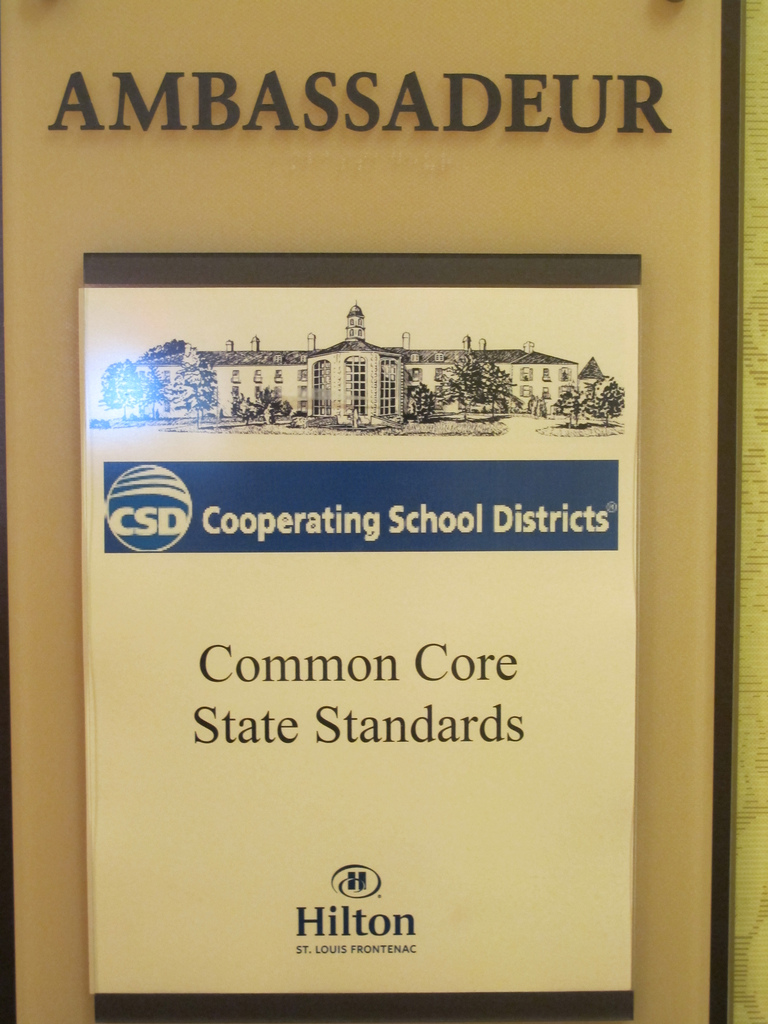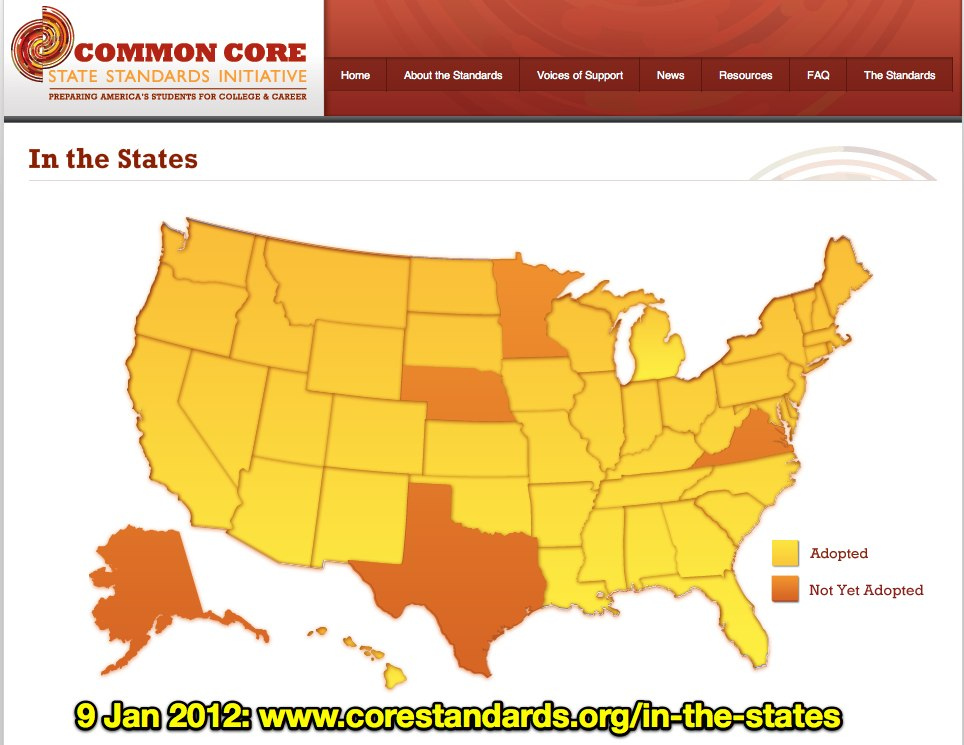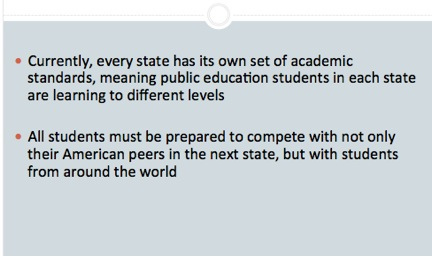If you have children in school, if you work in education, or if you are a consumer of national news, you have no doubt heard of the Common Core State Standards Initiative. Referred to simply as “Common Core”, this initiative has been around for years but is just beginning to be implemented nationwide. The purpose of this piece is to give readers insight into what Common Core is, how it has come to be adopted by forty-five states, why some love it and why some passionately oppose it. Over the coming months as Common Core begins being implemented, we will keep you up to date with new developments.
The Common Core State Standards Initiative is designed to bring diverse state curricula into alignment with one another and is sponsored by the National Governors Association (NGA) and the Council of Chief State School Officers (CCSSO). Originally, these standards were the brain-child of an organization known as Achieve in a partnership with the National Governors Association, with funding from the Bill and Melinda Gates Foundation. Per its website, Achieve is “a bipartisan, non-profit organization that helps states raise academic standards, improve assessments, and strengthen accountability to prepare all young people for postsecondary education, work, and citizenship.”
In 2010 the team behind Common Core introduced a set of math and English guidelines that could be adopted by the individual states, ostensibly on a voluntary basis. However, according to the Indy Star, “while 45 states have adopted the Common Core, don’t mistake that for enthusiastic, nationwide support. States were essentially coerced into adopting by the President’s Race to the Top program, which tied federal dough to signing on. Even if policymakers in recession-hobbled states would have preferred open debate, there was no time. Blink, and the money would be gone. Which isn’t to say there wasn’t opposition – there certainly was among policy wonks – but most people hadn’t heard of the standards at adoption time, and their effects wouldn’t be felt for several years.” The Atlanta Journal Constitution concurs, stating “While Common Core began in 2007, Obama “co-opted” Common Core for his education initiative, Race to the Top, requiring states to adopt the standards in order to be eligible for the multimillion-dollar federal contest that encouraged innovation in schools.” In other words, for a state to be eligible for these grants, they had to adopt the Common Core State Standards or a similar career and college readiness curriculum. With Common Core the only real game in town, the options were to opt in or lose out on funding dollars. It is not surprising that most states, facing spending challenges, took the offer and adopted Common Core. This is one of the reason detractors oppose Common Core–without really knowing what the initiative entailed, it was adopted under duress by many cash-strapped states.
Teachers attend a training on Common Core
So, what is the rationale for a program like Common Core? Alignment and continuity across the nation is a huge selling point. For decades, states have set their own standards; this means that if little Timmy were to move from one state to another, he may find that he is a grade level ahead in math or a grade level behind in reading. The problem with individual state standards is that they are, in fact, individual. If each state sets its own standards and adopts its own assessments, there is no way to ensure that all high school graduates have a grasp of the same essential skills in math and language arts. Common Core was created in part to minimize the learning gap between states. According to the Common Core website, “the standards are designed to ensure that students graduating from high school are prepared to enter…college programs or enter the workforce. The standards are clear and concise to ensure that parents, teachers, and students have a clear understanding of the expectations in reading, writing, speaking and listening, language and mathematics in school.” Essentially, the implied benefits of a program like Common Core are that all students will be learning the same concepts at the same point in time, all across the nation, making it a more seamless transition for students who move in and out of states, and ideally leading to a nationwide high school graduate population with the same basic knowledge and skill sets.
Of course, there are drawbacks. On its website, developers of Common Core acknowledge that “coming to consensus guarantees that from the viewpoint of any given state, topics will move up or down in the grade level sequence. This is unavoidable.” This means teachers across the nation will be given a new set of Math and Language Arts standards for their grade level. Most will be teaching things that used to be taught a grade before them or a grade after them, and the initial learning curve will be a steep one for educators tasked with facilitating the move to Common Core.
While advocates hail the homogenization of outcome expectations for students nationwide, this raises alarm bells for those who oppose Common Core. FreedomWorks, a national grassroots organization that promotes the rights of states to operate free from federal interference, argues “the Common Core Standards Initiative sets Math and English curriculum in every participating state at the same level. In adopting this ‘common core’ states are relinquishing their right to compose their own education requirements… Putting a stop to implementation of the Common Core would preserve a measure of sovereignty for states to dictate their own, individualized requirements.”
FreedomWorks is not alone in their opposition to Common Core. Michigan lawmaker Tom McMillin concurs, saying “We don’t want our kids to be common. We want our kids in Michigan to be exceptional.” Iowa Senator Chuck Grassley has gone so far as to draft a letter of opposition, cosigned by Mike Lee (R-Utah), Tom Coburn (R-Okla.), James Inhofe (R-Okla.), Deb Fischer (R-Neb.), Rand Paul (R-Ky.), Pat Roberts (R-Kan.), Jeff Sessions (R-Ala.), and Ted Cruz (R-Texas). These leaders maintain “parents ought to have a straight line of accountability to those who are making the decisions. State legislatures, which are directly accountable to the citizens of their states, are the appropriate place for those decisions to be made, free from any pressure from the U.S. Department of Education.”
So, who benefits most from the adoption of Common Core standards? It depends on whom you ask. Supporters believe that children will reap the greatest benefit as they will ideally all be on the same educational page regardless of where in the nation they receive their education. Those who praise Common Core also argue that it will benefit teachers by telling them exactly what outcomes they need to teach, and will benefit parents by giving them a roadmap of what to expect their children to be learning from grade to grade.
Presentation given by Pearson Educational Publishers
Skeptics argue that the real beneficiaries are the textbook manufacturers and those who create national assessments. Publishers like Pearson and McGraw-Hill are presenting revamped textbooks to schools nationwide promoting their alignment with Common Core. David Coleman, President of the College Board, has announced that the SAT will be changing to reflect the Common Core standards, meaning anyone who wants to excel on this popular college entrance exam must learn the standards, even if they attend private schools, home schools, or schools in states where Common Core has not been adopted. This basically forces the hand of parents, teachers and students nationwide to get on board or get left behind. Not a lot of choice for a “voluntary” initiative. The waters are further muddied by the fact that the same David Coleman who is head of the College Board is the man who was initially tasked with helping to develop/draft the Common Core standards. So, the man who was instrumental in writing the curriculum is now poised to reap the financial benefits on the assessment side of the equation.
Assessments are changing at the lower educational levels as well. Tony Alpert, COO of assessment company SmarterBalanced, has stated that the company’s explicit job is to create Common Core State Standard assessments. In Iowa, schools will no longer be giving the Iowa Assessments (formerly known as the Iowa Tests of Basic Skills) as they will instead be giving students the SmarterBalanced assessments. Of course, SmarterBalanced supports the move to Common Core standards, but they also stand to benefit from the resulting need for new assessments.
Love them or hate them, the Common Core standards are here and are posed for nationwide implementation. Nevertheless, a handful of states have chosen not to adopt the standards, while several others are experiencing strong grassroots-level pushback. Expect this educational battle to wage on through the summer and into the fall.






2 comments
Kristel:
Thanks for your feedback! In all honesty I wasn’t trying to be partisan as much as I was trying to get at the forces behind Common Core’s nationwide implementation. For full disclosure I was adamantly against the Bush Administration’s “No Child Left Behind”, too, and as a teacher I can say that if the Department of Education was cut in half (or more) that would be fine with me, as it has become a huge force and one that I believe we could do without.
As for the blaming, my point was that Common Core’s implementation became tied to the “Race to the Top” monies. Schools wanting the extra funding were basically compelled to adopt Common Core, and I am not okay with that. The current administration is the one who tied the two together, which is why they were mentioned. I agree that David Coleman of the College Board is one of the real culprits here, along with textbook manufacturers and other makers of student assessments. How convenient for Mr. Coleman that he was tapped to help craft the standards used in Common Core and he also happens to be the one developing the college entrance exams that will basically force school districts’ hands in adopting Core if they want their students to do well on college entrance tests like the SAT. He’s basically scratching his own back. Further, of course textbook companies like Pearson are eager to see new standards adopted, because they can then churn out new must-have textbooks to be sold to schools across America.
I heard it said at a curriculum meeting recently that “You can’t burn out a bad teacher” because they will always find ways to skirt the system and shirk responsibility. However, you can burn out dedicated,caring teachers who find themselves jumping through more and more hoops every day just to get to the place where they can teach the reading, writing and arithmetic that used to be the focus of their duties. There are far too many fingers in the educational pie these days, in my opinion.
The author tries her best to keep the deep roots of this erosion to our grossly disfigured education ‘system’ nonpartisan, however, the faint references to our current administration being responsible is again dividing. This continues to be our greatest problem in our policy making abilities. Nothing is getting done, no communication is happening, and the wrong people continue sitting at the table ‘not’ talking. The message of who ‘muddied the waters’ should not have been reserved for the end of the article, the true venom of this article Mr. David Coleman. Shame on the Department of Education and the elected officials who allowed this atrocity to occur. No one person or party is too blame and for the USA to move forward, we need to stop taking sides and vow to come together to work.